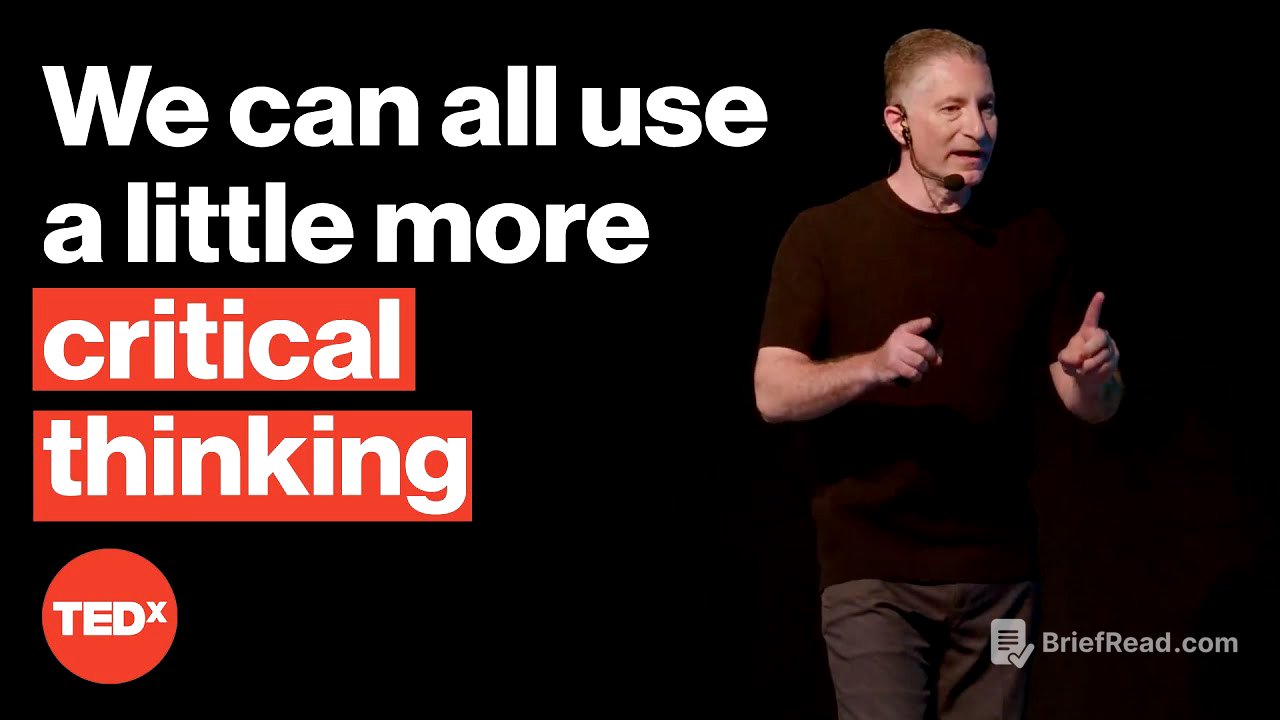TLDR;
This TEDx talk addresses the critical need for improved critical thinking skills in today's world. It highlights the alarming lack of critical thinking abilities among students and professionals, and introduces a novel approach to teaching critical thinking based on the brain's natural functions. The speaker outlines a four-step method rooted in evolutionary biology, designed to simplify and the teaching of critical thinking without sacrificing its complexity. This method has shown promising results in various educational settings, fostering deeper analysis, improved decision-making, and enhanced communication skills.
- Critical thinking is essential for addressing complex global issues.
- Current critical thinking education is inadequate.
- A new method based on primal brain functions can effectively teach critical thinking.
- Improved critical thinking skills lead to better decision-making and academic performance.
Introduction: The Importance of Critical Thinking [0:20]
The speaker emphasizes the importance of critical thinking, especially when facing serious global issues like war, climate change, and political strife. They highlight the deficiency in critical thinking skills, questioning if anyone believes there's an excess of it. The speaker then introduces their work in founding the Critical Thinking Institute in 2011, driven by the goal of teaching critical thinking to everyone, from children to adults, across various educational and professional settings.
The Problem: Lack of Critical Thinking Skills [2:21]
The speaker presents research indicating a significant lack of critical thinking skills among young people and college students. Studies from the Stanford History Education Group and The Wall Street Journal reveal that teens struggle to reason about online information and college graduates show minimal improvement in critical thinking over four years. Furthermore, brain monitoring studies suggest reduced brain activity among students during class, highlighting the ineffectiveness of current educational methods in fostering critical thinking.
The Sandbox Problem: Simplifying Complexity [4:16]
The speaker introduces the "sandbox problem," illustrating the complexity of critical thinking even in simple scenarios like children playing in a sandbox. They pose the challenge of simplifying the teaching of critical thinking to make it accessible to everyone without undermining its inherent complexity. The goal is to identify a method that addresses the multifaceted nature of critical thinking observed in everyday situations.
The Solution: Evolutionary Approach to Critical Thinking [6:20]
The speaker describes the approach of tracing back the origin of how the human brain evolved to think critically, starting from single-cell organisms in primordial ooze. Evolutionary biologists suggest that these organisms were capable of four thinking acts: perceiving their environment, sensing danger and reward, deciding between them, and acting on the decision. These acts form the foundation for more advanced critical thinking. The speaker proposes converting these primal acts into a critical thinking system to solve the sandbox problem.
Four Primal Acts of Critical Thinking [9:32]
The speaker outlines a four-step method based on the brain's natural functions:
- Detailed Analytic Observation: Augmenting the brain's observational mode to extract more details from any subject, whether it's a play, simulation, or proposal.
- Complex Question Clarification: Enhancing the brain's assessment of danger and reward by teaching techniques for clarifying complex questions.
- Multivariant Evaluation: Improving the brain's reasoning mode by enabling the ability to weigh multiple factors simultaneously.
- Complex Conclusion Formation: Developing the brain's capacity to draw conclusions that do justice to complex situations.
This method simplifies critical thinking into four primal acts that the brain performs daily.
Core Skills of Thinking [11:38]
The speaker emphasizes that while math, writing, and reading are taught, critical thinking often isn't, potentially because the core skills of thinking haven't been identified until now. They posit that the four steps described are the core skills, enabling other critical thinking acts like problem-solving, strategizing, and innovating. These acts depend on the primal skill of critical thinking, which can be learned by anyone.
Results and Impact [13:52]
The speaker shares positive outcomes from implementing this method, including undergraduate students producing graduate-level work after just one course. A two-week intervention in a Harlem high school led to increased critical thinking skills and more complex sentence structures. Class discussions became richer, with students respecting each other's reasoning processes. The method worked across various disciplines and positively impacted students' decision-making in their personal lives.
Conclusion: A Call for More Critical Thinking [15:54]
The speaker concludes by stating that they have solved the sandbox problem by building critical thinking on natural brain functions, making it accessible to everyone regardless of age or education. This method not only simplifies critical thinking but also augments its complexity. The speaker emphasizes that critical thinking skills are the biggest determinant for high-stakes decisions and the number one skill employers seek. Given the problems facing the world today, the speaker calls for more critical thinking.









